Unraveling the LED Binning Mystery: From Cookies to Colors
LEDdynamics Director of Education, Sam Colwell, simplifies LED binning and goes in-depth about how LEDdynamics assures quality products.
LEDdynamics Director of Education, Sam Colwell, simplifies LED binning and goes in-depth about how LEDdynamics assures quality products.
Adopting tunable white LED lighting is a forwarding-thinking choice aligned with the future of lighting and wellness trends.
Not all tunable white LED lighting systems are the same. LEDdynamics have developed a superior model that truly matches the light of the sun. Its name: PERFEKTLIGHT. To find out more, let’s explore how tunable white lighting works.
Tunable white lighting adjusts the color temperature of white light. When it’s set up to match the changing of the sun’s light through the day, this can have multiple benefits on our health. This is because it helps to restore our circadian rhythm, another name for our natural body clock.
Sunlight’s Affect on Human Physiology
If we had a perfect lifestyle, we would wake up every day at sunrise, and fall asleep when it gets dark. Our bodies are designed to do this: they produce melatonin, a natural sleep hormone, in reaction to darkness.
However, in our modern world, we have disrupted this process completely. Most notable, we often substitute natural daylight with artificial light. Fortunately, artificial light can now replicate the behavior of sunlight, allowing us to restore our circadian rhythms.
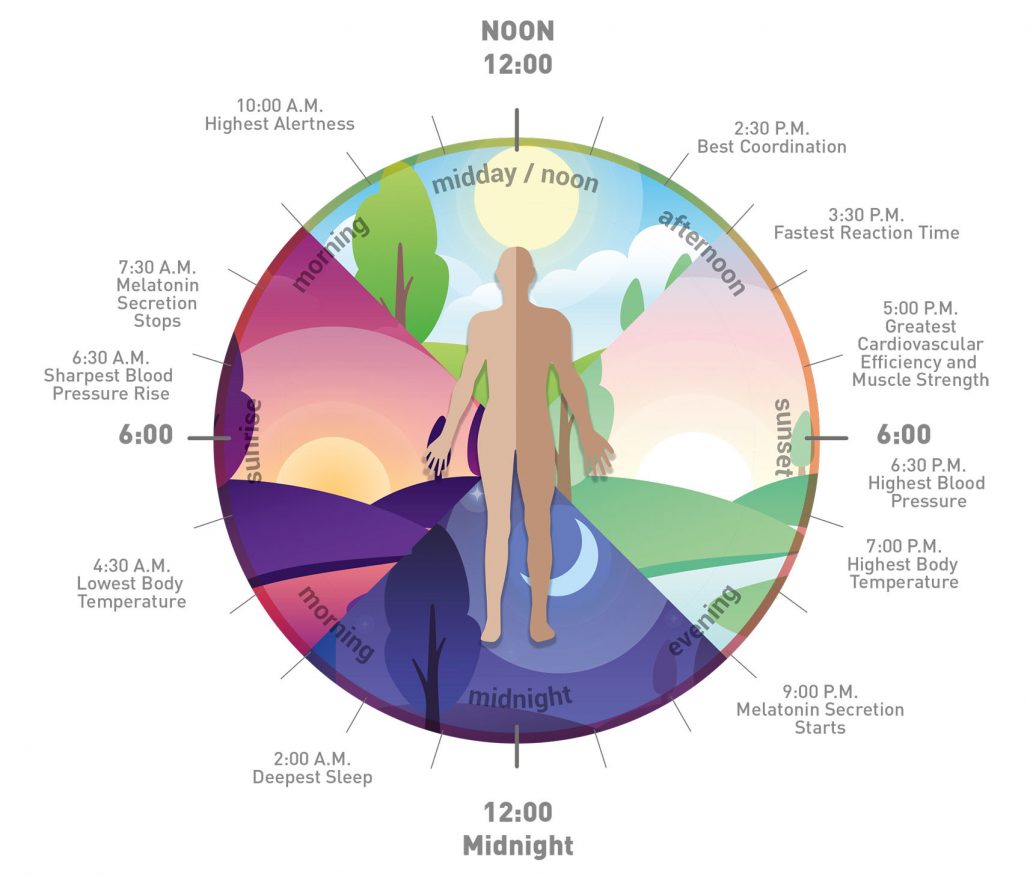
Sunlight Replicated Using Electric Lighting
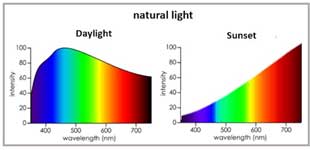
SPD of natural daylight & sunset – NOTE DAYLIGHT peak at 482nm
Replicating sunlight using electric light poses certain challenges. To appreciate these, we need to understand something called the Spectral Power Distribution (SPD) of sunlight. SPD describes the power of light at a given wavelength. Daylight SPD is rich in blue, but changes throughout the day and as the afternoon draws in it progresses to red. SPD and its progression through the day is extremely important to our circadian rhythms.
Recently, scientists have proven that our eyes contain a non-visual ipRGC (intrinsically photosensitive retinal ganglion cell) receptor, which is most sensitive to blue light at 482 nanometers. During the day, sunlight provides a high level of this blue wavelength. The blue blocks melatonin production, helping improve alertness and productivity. Then, as the afternoon progresses, the sun’s SPD drops in blue and shifts to red, helping kick-start the sleep cycle.
Typical White LEDs & Blue-light Issue
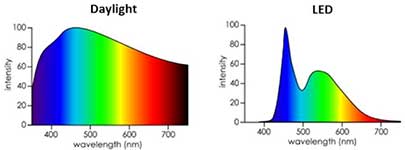
Daylight versus LED – NOTE BLUE spike at 450nm and trough at 482nm
However, the blue color in the SPD of most LED lights is very different to that of sunlight. This is because of a phosphor coating placed upon blue LEDs.
Most tunable white systems can emulate the visible shift in color temperature of sunlight, but due to the blue spike (see image on right), fail to offer the non-visual light important to circadian rhythm. They wind up either suppressing melatonin too little during the day, or creating an uncomfortable setting high in glare and brightness.
To suppress melatonin during the day with a neutral-white light, the space would need to be over-lit, creating a glare that makes people uncomfortable. Using a cool-white LED with appropriate light levels, could also make people uncomfortable because of the blue color temperature of 6500-Kelvin.
Because typical LEDs have a low SPD at 482nm, combining such LEDs in color tuning system fails to replicate sunlight and limits the system’s ability to promote a healthy circadian rhythm.
A New Solution
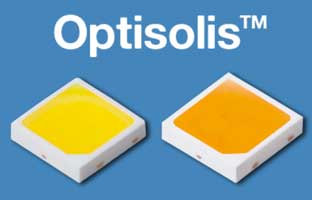
PERFEKTLIGHT uses high CRI Nichia Optisolis LEDs
It is now possible to create tunable white lighting systems that use the broadest SPD and phosphors that both present very high Color Rendering Index (CRI) and significantly reduce inappropriate blue light in morning and evening.
The Nichia’s Optisolis LEDs, which provides the highest CRI, can eliminate the trough at 482nm and should help suppress the overproduction of melatonin due to excessive blue light at 450nm.
PERFEKTLIGHT
Compared with typical white LEDs, Nichia’s Optisolis LEDs minimize the blue peak and fill in the trough in the SPD. Critically, the SPDs of these LEDs equal the SPD of sunlight. Consequently, this is done through combining warm-white and cool-white Optisolis lights. One more element is needed to make sure the light accurately tracks the sun’s daily progress. This is the addition of green light, which allows the light to fully match the Blackbody Locus (BBL). The BBL is the curve that defines white light within the color space. Through combining Optisolis LEDs with the green correction, we created PERFEKTLIGHT. Its name comes from the fact that it matches the sun’s behavior perfectly.

SPD of PERFEKTLIGHT – NOTE low blue light level of warm color temperature for morning and evening versus the higher blue light level of neutral and cool-white color temperatures during daytime
PERFEKTLIGHT is the tunable lighting system that truly matches our natural circadian rhythm. Application software and “set and forget” controls allow the light to be preset to your exact geographical location.
 Covid-19 is on everyone’s mind these days, and there is good reason for that. This single event has upended our lives, some more than others – but every life to some extent. It makes sense, therefore, that we would go looking for solutions wherever we think we could find them. If we believe that there is a piece of technology that promises to prevent any more suffering, to open our economy up, and to get us back to some sense of normalcy, then it is worth examining: especially if that technology has led to definitive results.
Covid-19 is on everyone’s mind these days, and there is good reason for that. This single event has upended our lives, some more than others – but every life to some extent. It makes sense, therefore, that we would go looking for solutions wherever we think we could find them. If we believe that there is a piece of technology that promises to prevent any more suffering, to open our economy up, and to get us back to some sense of normalcy, then it is worth examining: especially if that technology has led to definitive results.
This is Utraviolet (UV). Before you even ask, yes, UV can kill covid-19. Do you know the UV that you soak up when you are sunbathing or spending a day at the beach? It is capable of killing the virus that has sent our entire world into a tailspin. Before you get your hopes up too high, though, you should realize that not all UV light is the same. There is some UV light that is not nearly as effective at killing covid-19 – at least not before it causes some serious damage to you and your body.
Take UV-A, for example. The longer wavelengths, which we can see, are ineffective at killing covid-19 and eradicating germs in the way that other UV light can. To be effective, UV-A needs to emit in massive amounts, far past the point of practicality. UV-B, for the most part, seems similarly ineffective.

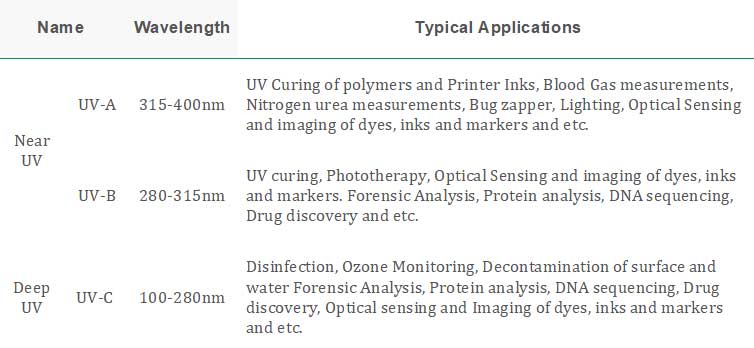

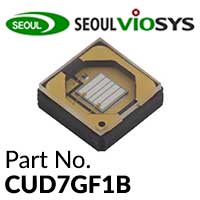 It is UV-C that is of most interest to us. At LEDdynamics, we have devoted ourselves to creating UV light products that are effective and that match up with consumers’ specific needs: the Seoul, which offers a lower output and thus a lower cost, and the Nichia, which offers a higher output and thus a higher cost.
It is UV-C that is of most interest to us. At LEDdynamics, we have devoted ourselves to creating UV light products that are effective and that match up with consumers’ specific needs: the Seoul, which offers a lower output and thus a lower cost, and the Nichia, which offers a higher output and thus a higher cost.
In this post, we are going to review all of the information that you need about UV-C for sterilization, including why it is effective at all and what that means for your health throughout the covid-19 pandemic and beyond.
As you would expect, interest in UV light technology has boomed since the covid-19 pandemic emerged. Everyone wants to know if this technology can provide the respite that we are all craving. Is this the tool that is going to change our lives? Because of this massive increase in interest, it makes sense that we would consider what is out there. The technology that you will find available in many places is not, unfortunately, quite up to the LEDdynamics standard.
None of this is pie-in-the-sky science, either. Versions of germicidal UV light have found uses since the late 19th century, and when the Ebola virus broke out in West Africa in 2014, engineers and consumers alike turned their attention to the technology, which had remained mostly confined to close-up surface disinfection.
When applied to surfaces, UV-C light within the 200-to-280 nanometer range can kill bacteria and spores and “deactivate” covid-19 (the fancy term we use for “kill” since viruses aren’t technically alive).
As you would also expect, technology over the last several months has improved rapidly. Everyone knows what is at stake here: if UV-C is both practical and effective to the degree that we need it to be, it could move all of our lives forward, out of this nightmare once and for all.
So, how do we get there? How do we push UV-C to the point of practicality and efficacy that it can be world-changing?
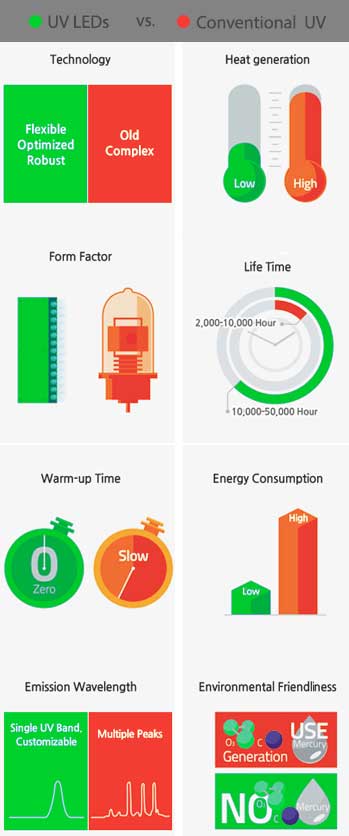 The first and most significant step that we can take toward this goal is to realize that if we want to optimize UV lights, we need to forget about conventional lamps altogether. The same shift that businesses and consumers have made in order to cut costs and improve lighting ambiance is the shift that we need to make in order to put UV light to work for us – embracing LEDs and all of the benefits that they have to offer.
The first and most significant step that we can take toward this goal is to realize that if we want to optimize UV lights, we need to forget about conventional lamps altogether. The same shift that businesses and consumers have made in order to cut costs and improve lighting ambiance is the shift that we need to make in order to put UV light to work for us – embracing LEDs and all of the benefits that they have to offer.
The first benefit of LED UV lights is how much more energy-efficient they are than conventional UV lights, meaning that you do not need to make any alterations to your infrastructure in order to use them. To get started with an LED UV light, you plug it into the same wall outlet that you would use for all of your other lights – as simple and as straightforward can be.
Building on this, an LED UV light does not require you to keep it running when you are not using it – which conventional UV lights do, requiring lengthy warm-up periods to function at all. You can turn an LED UV light on and off at will, confident that its effects will begin as soon as you press the “on” button, no warm-up period necessary. A warm-up period also means that conventional UV lights become uncomfortably warm wherever you place them, and LED UV lights do no such thing.
Conventional UV lights, meanwhile, emit ozone, which is hazardous to people, causing breathing problems if the area is poorly-ventilated. Since the last thing that you want is to introduce environmental respiratory issues in an effort to ward off a respiratory illness, the LEDs’ advantage on this front is substantial.
Add to the inconveniences and hazards of these challenges – the warm-up time and the ozone – the fact that they are going to create additional costs for business and consumers. Anyone who uses a conventional UV light must then plan on making up for the additional energy expenditures and ventilating the area properly.
Using an LED UV light, you never need to worry about any of that.
As if all of this were not convincing enough, there is also an environmental aspect to it. While the mercury in conventional UV lights can seep out of the light and damage the environment, there is no such concern for LED UV lights – which will, in turn last longer and remain more efficient throughout their lifespan.
All of this information is certainly exciting if you have never heard it before. If you are new to UV lighting, then you are probably thinking “Sign me up for some LEDs!” While we would agree with you, we would also suggest learning a little bit more about the technology first. This is not a solution that is without risk. There are risks to UV lights, just as there are drawbacks and limitations.
As David Sliney of the Illuminating Energy Society puts it, incomplete information about germicidal UV and other UV technology may create “a false sense of security.” The fact of the matter is that this is neither a panacea nor a put-it-up-and-forget-it sort of tool. You cannot place a UV light somewhere and assume that it is going to destroy every virus in the room. If anything does not come into contact with the light, you should assume that it is still potentially contaminated – because UV light can only deactivate covid-19 by coming into contact with it.
 Another point is that UV germicidal light can become dangerous itself through improper installation or usage. UV-A and UV-B light, for instance, can damage our eyes and our skin if too much of it hits us. UV-C seems safer, however, because the outer, dead layer of our skin tends to absorb most of it, unlike UV-A and UV-B, both of which are much more effective at penetrating through to the lower layers of our skin.
Another point is that UV germicidal light can become dangerous itself through improper installation or usage. UV-A and UV-B light, for instance, can damage our eyes and our skin if too much of it hits us. UV-C seems safer, however, because the outer, dead layer of our skin tends to absorb most of it, unlike UV-A and UV-B, both of which are much more effective at penetrating through to the lower layers of our skin.
Yet another point is that we cannot expect UV light to break through one surface into another. Unless we are shining it onto surfaces that are clear and clean – free of dust, free of soil, free of any contaminants at all – it is almost a sure thing that it will not disinfect the surface effectively.
What, then, does proper installation and usage look like? Since we know that UV light can be useful and that, given its 70-plus-year usage, it can be safe, how do we arrive there?
The key is to temper our expectations. If we think about UV light as a cure-all and assume that we can do whatever we want because we are shining it onto the surfaces in our home, office, and/or gym, we may end up unpleasantly surprised. The Illuminating Energy Society describes germicidal UV as a “complementary” technology, adding to an overall strategy based on cleanliness, hygiene, and sanitation.
 Once we have put UV into perspective and we recognize that UV-C light is the most interesting to us of all the UV lights, it makes sense to ask – how does it actually work? How can a light deactivate a virus and kill a germ?
Once we have put UV into perspective and we recognize that UV-C light is the most interesting to us of all the UV lights, it makes sense to ask – how does it actually work? How can a light deactivate a virus and kill a germ?
This comes down to the short wavelength of UV-C. That short wavelength can break down the RNA that makes up covid-19 and other virus strains, preventing them from making copies of themselves, which is how viruses propagate, each strain making another copy and another and so on. The process is similar for bacteria, the UV getting in the way of the bacteria’s DNA so that they cannot replicate either.
Specifically, there are two variables that concern us when we are implementing UV-C light for sterilization: the time that we are exposing the light to the surface and the power that the light is emitting. While it may seem very basic, almost as if it were made up, researchers have determined that 17 megawatts of a 254-nanometer lamp-emission radiant power per cubic meter of space is ideal for disinfecting the air. This is assuming, of course, that the air is going through some sort of a treatment system. If not, then the process may take more time to become effective.
The sterilization process that we have described applies to both conventional and LED lights. That does not change. What does change, however, is the efficiency of the lighting fixtures otherwise. Here is the problem that has persisted: for some time, LED lights have been available in UV-A form but not in UV-C form. This is largely why LED UV lights have remained out of the conversation.
Finally, we are seeing progress in this area.
LED UV-C lights are now tenable. There are two particular examples of LED UV-C lights that seem bound to become widely-accepted: the Seoul Viosys and the Nichia. Let’s take a look at each of these cutting-edge LED UV-C light solutions:
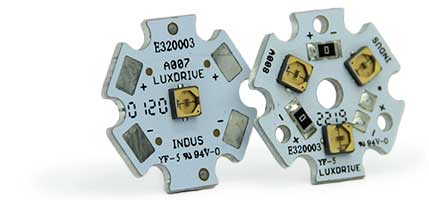
Seoul UV-C LED Light Module from LUXdrive
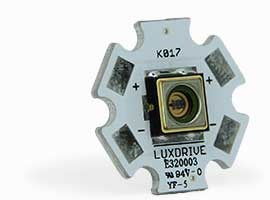
Nichia UV-C LED Light Module from LUXdrive
This is it: the best of both worlds. By combining LEDs with UV-C, we are talking about the stuff of dreams, the sort of innovation that epidemiologists, world leaders, and medical professionals had for years hoped would come along – and that they have hoped even more stridently, with bated breath, would come along ever since this pandemic took so much from all of us.
So, where else can this technology can go?
That is the question we have asked ourselves at LEDdynamics. Throughout the covid-19 pandemic, we have watched as our friends and family have struggled to make their way from one month to another, never quite sure what is going to happen next and what we can do to make our way out of this period in our lives.
UV-C light may not be the only answer, but it is one viable answer, a workable solution that we can use to fight back against covid-19. We are working hard to help our clients adopt LED UV-C lighting into their homes, their offices, their gyms, their businesses, and other living spaces. We offer world-class services in this area, overseeing board design, thermal design, and LED power supply installations and helping to determine the number of LEDs that is appropriate for your system.
To learn more about the guidance and support we can provide with regards to LED UV-C solutions, contact us today.
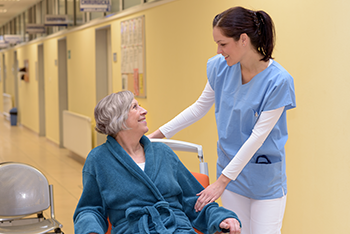 More than anyone else, people in nursing homes struggle to find high-quality sleep, which is especially disheartening because we know that elderly people are more susceptible to health issues, which poor sleep can exacerbate. While this is a complex issue, there is a good deal that we can do about it because we understand how our brains decide when it is time for us to be awake and when it is time for us to be asleep. It comes down to our circadian rhythm, which melatonin regulates. Naturally, it was the absence of the sun that would initiate melatonin production. This is still true, but other variables have come into play.
More than anyone else, people in nursing homes struggle to find high-quality sleep, which is especially disheartening because we know that elderly people are more susceptible to health issues, which poor sleep can exacerbate. While this is a complex issue, there is a good deal that we can do about it because we understand how our brains decide when it is time for us to be awake and when it is time for us to be asleep. It comes down to our circadian rhythm, which melatonin regulates. Naturally, it was the absence of the sun that would initiate melatonin production. This is still true, but other variables have come into play.
![]() Let’s dive into this a little deeper. When we talk about melatonin production and sleep, we need to talk about the circadian rhythm too. This is what determines how our brain directs our sleeping and waking functions, and while you may be able to fall asleep when you are outside the rhythm, sleep quality will suffer. This is because the hypothalamus inside the brain struggles to operate properly when the circadian rhythm is out of alignment with reality, and when its suprachiasmatic nucleus (SCN) cannot work in conjunction with the optic nerve behind the eye, it receives unclear signals about light and darkness and makes inaccurate conclusions about day and night.
Let’s dive into this a little deeper. When we talk about melatonin production and sleep, we need to talk about the circadian rhythm too. This is what determines how our brain directs our sleeping and waking functions, and while you may be able to fall asleep when you are outside the rhythm, sleep quality will suffer. This is because the hypothalamus inside the brain struggles to operate properly when the circadian rhythm is out of alignment with reality, and when its suprachiasmatic nucleus (SCN) cannot work in conjunction with the optic nerve behind the eye, it receives unclear signals about light and darkness and makes inaccurate conclusions about day and night.

For thousands of years – the vast majority of history, even the majority of some older people’s lives – all of this information would have been interesting but certainly not immediately relevant. If you experienced minimal or no exposure to artificial lighting, how could this information have been relevant? Today, though, we all come into contact with artificial lighting, almost constantly, and at night, that spells trouble for the circadian rhythm. Just when your brain is trying to figure 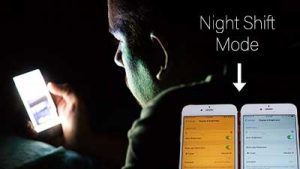 out when it is time for you to go to sleep and when it is time for you to wake up, you are looking at your phone or your tablet, exposing yourself to blue light, and throwing your circadian rhythm out of sync.
out when it is time for you to go to sleep and when it is time for you to wake up, you are looking at your phone or your tablet, exposing yourself to blue light, and throwing your circadian rhythm out of sync.
For younger, healthier people, it is possible to throw the circadian rhythm out of sync and still fall asleep at night. It is possible in the way that it is possible to eat unhealthy foods for a day without falling ill, but it is not the ideal. In nursing homes, on the other hand, sleep challenges are already widespread. If you have ever visited a nursing home yourself, then you may have observed these challenges in action, the difficulties that many residents face when they are trying to sleep or when they are trying to go about their days and inadvertently falling asleep. As one study out of the University of California put it, “Although older community-dwelling adults are more likely to take naps than younger adults, the typical long-term care resident shows a pattern of wakefulness that is frequently interrupted by brief periods of sleep.”
 When sleep issues already run rampant, any solutions could prove groundbreaking, and in nursing homes, sleep challenges do run rampant. Before the influx of blue light that smart phones and smart pads ushered in, sleep quality was already critical to elderly people because of the health issues that arise from poor sleep. Falling short of their sleep requirements and falling ill or sleeping during the day, during inopportune moments, elderly people may try to make up for sleep that they missed at night, but as research has shown, this concept is false: we cannot make up for sleep once we have missed it. As you surely know yourself if you have ever tried to go through a Monday on only two or three hours of Sunday-night rest, quality of sleep impacts quality of life, but what else does it mean for people? How does a smooth circadian rhythm affect our lives?
When sleep issues already run rampant, any solutions could prove groundbreaking, and in nursing homes, sleep challenges do run rampant. Before the influx of blue light that smart phones and smart pads ushered in, sleep quality was already critical to elderly people because of the health issues that arise from poor sleep. Falling short of their sleep requirements and falling ill or sleeping during the day, during inopportune moments, elderly people may try to make up for sleep that they missed at night, but as research has shown, this concept is false: we cannot make up for sleep once we have missed it. As you surely know yourself if you have ever tried to go through a Monday on only two or three hours of Sunday-night rest, quality of sleep impacts quality of life, but what else does it mean for people? How does a smooth circadian rhythm affect our lives?
Irritability, poor concentration, poor memory, slower reaction times, decreased performance: these are all well-known symptoms of low-quality sleep. In the elderly – in particularly the elderly who suffer from dementia, a condition already associated with the same symptoms – these symptoms can become overwhelming, to the point that research published in Neuropsychiatric Disorders and Treatment concluded that over a ten-year period, there was a link between insomnia and elderly suicide.
Knowing this, we also know that we need to do something to respond to these challenges. The Pandora’s box of blue light is open, and there is no turning back. We can encourage people to avoid their phones in the evening over and over again, but we need something more active to respond to these challenges effectively. To determine how we can respond to these challenges, it is useful to look beyond circadian rhythm and its theoretical effects and consider the real-world effects of circadian rhythm in nursing homes – and how circadian lighting can make a difference.
To figure out what circadian lighting could mean to nursing homes, we can look to the research. One study from the US Department of Energy is especially encouraging, pointing to the game-changing numbers that they have seen circadian lighting drive and the inimitable impact that this lighting can have on populations where the rates of sleep disturbances are high – as we said, even affecting a majority of all the people within the population.
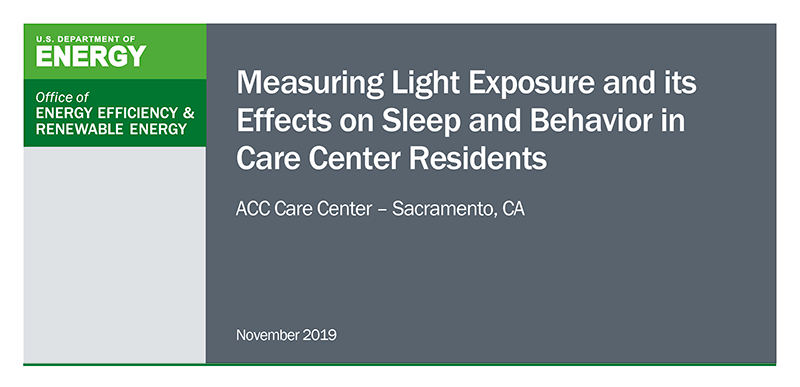
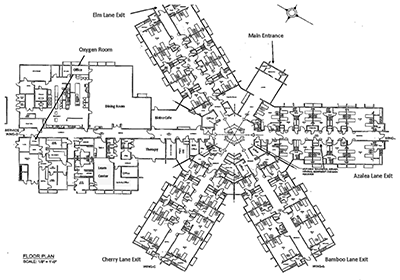 In this study, out of the ACC Care Center, researchers consider the residents of the 99-bed facility as a whole. They stated, “The objective was to test a strategy for measuring and documenting light exposure for typical residents, and to evaluate the collected data in terms of multiple metrics for human circadian responses over the course of a day.” This is an important point to make because, as they also point out, this science is still new. Newer than the blue-light-emitting devices that exacerbated these sleep issues in the first place. Dependable tunable white lighting is an innovation that, unfortunately, most nursing home professionals and administrators have not heard of. When we see the undeniable effects of circadian lighting in nursing homes, that is the only explanation that would make any sense, too.
In this study, out of the ACC Care Center, researchers consider the residents of the 99-bed facility as a whole. They stated, “The objective was to test a strategy for measuring and documenting light exposure for typical residents, and to evaluate the collected data in terms of multiple metrics for human circadian responses over the course of a day.” This is an important point to make because, as they also point out, this science is still new. Newer than the blue-light-emitting devices that exacerbated these sleep issues in the first place. Dependable tunable white lighting is an innovation that, unfortunately, most nursing home professionals and administrators have not heard of. When we see the undeniable effects of circadian lighting in nursing homes, that is the only explanation that would make any sense, too.
For their study, researchers for the US Department of Energy depended on three models for circadian wellness, each of which purports to tell us how light is impacting sleep quality: melanopic/photopic (M/P) ratios, equivalent melanopic lux (EML), and circadian stimulus (CS). Let’s consider each of these models.
For an M/P ratio, we are considering the melanopic content and the photopic content, both measured at the eye. Sometimes, experts will refer to this as the “blue-cyan content” because that is what it is describing, the blue light that is at an eye. When the M/P ratio is high, it leads to wakefulness, and when the M/P ratio is low, it leads to sleepiness.
An EML, meanwhile, accounts for the radiant watts that our ipRGC photoreceptors detect and the photopic content at the eye – again, higher equating to more wakefulness and lower equating to more sleepiness.
Then, there is CS, which measures the suppression of melatonin, once again the higher values equating to wakefulness and the lower ones equating to sleepiness.
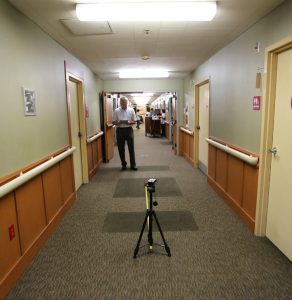 The researchers for the ACC Sleep Center study used what we call “spectrophotometers” (Konica-Minolta CL-500a) read the radiant energy data necessary to calculate M/P ratio, EML, and CS, detecting light in the nursing home environment so that they could compare their readings to the objective reports that the nursing home residents submitted regarding their sleep quality. From this, we can extrapolate calculations and objective reports into conclusions about the effects of different types of lighting on elderly people’s sleep quality.
The researchers for the ACC Sleep Center study used what we call “spectrophotometers” (Konica-Minolta CL-500a) read the radiant energy data necessary to calculate M/P ratio, EML, and CS, detecting light in the nursing home environment so that they could compare their readings to the objective reports that the nursing home residents submitted regarding their sleep quality. From this, we can extrapolate calculations and objective reports into conclusions about the effects of different types of lighting on elderly people’s sleep quality.
Making a point of controlling the static lighting at 4100K, the researchers strove to imitate the eye lighting conditions in the morning for all residents so that they could say more definitively that they were observing results caused through nighttime lighting conditions. This means that when we are reviewing the statistics and conclusions in this study, we can say with a high degree of confidence that we are reviewing the effects of nighttime lighting conditions as well.
The researchers also worked from an assumption that has become mostly universal by now among those who are familiar with the different types of lighting and their effects: low, warm-color light leads to stronger melatonin production, which leads to higher sleep quality. Pictures were taken of the same corridor, but at different times of the day to provide a visual example of the tuning range (Photo from Report is Below).
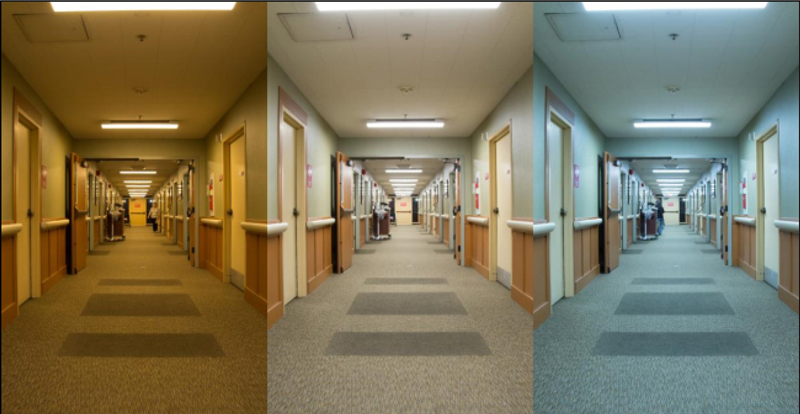
Time and again, the outcome was clear: tuned white lighting made a difference. Anything but indecisive, their research showed a significant gap between the sleep disturbances that residents experienced when exposed to old styles of lighting and the sleep disturbances their counterparts experienced when exposed to cutting- edge tuned white lighting. Static lighting, repeatedly, correlated with higher incidences of sleep disturbances in this nursing home.
edge tuned white lighting. Static lighting, repeatedly, correlated with higher incidences of sleep disturbances in this nursing home.
It is important to realize that the static lighting the researchers used was no different from the static lighting that nearly all nursing homes are using at this very moment. The environments that they replicated for their study would have been indistinguishable from many other real-world nursing home environments, which begs the question: how many elderly people are suffering needlessly? How many people in nursing homes are laying awake at night, unable to get their circadian rhythms in balance, unable to fix their melatonin production, falling asleep in the middle of the next day when their families are visiting them? What are the repercussions of sleep disturbance in regards to the nursing staff?
The gap between static lighting and tuned white lighting, it turns out, is a chasm. You may be wondering, How serious could the difference have been? As far as science goes, the answer is very. Exposed to tuned white lighting, residents experienced only half as many sleep disturbances as they would have exposed to static lighting – 1.8 versus 3.6. In research of this kind, that is the type of determinative difference that researchers are looking for, either to confirm their hypothesis or deny it. When only half as many nursing home residents are experiencing sleep disturbances while exposed to some stimulus, that stimulus merits further attention, to say the least.

Researchers were even more direct in their conclusions about the study, stating that “The intervention likely worked to reduce sleep disturbances in the 5% to 7% of residents with many severe sleep disturbances.” While 5% to 7% is a minority of all residents, it would be difficult to overstate how life-altering it could be to reduce their severe sleep disturbances because, again, these challenges result in more than irritability and poor concentration. Over time, severe sleep disturbances, like insomnia, can lead to a number of irreversible health issues, up to and including suicide.
The researchers, reviewing their M/P ratio, EML, and CS calculations, determined that tunable white lighting was effective at cutting down on blue-cyan content at night and at delivering higher levels of blue-cyan content in the morning and during the day, when wakefulness becomes important. In every way, this lighting seemed capable of improving quality of life at the ACC Care Center, calculation after calculation turning out positive and in favor of the newer lighting type.
Astoundingly, the researchers for the US Department of Energy also reported that “[I]n an institutional setting with shared rooms, such as the nursing center in this study, improving the sleep of a few residents may have a ripple effect on roommates and closely located others.” Put another way, we can create a wave of health benefits by improving nursing home residents’ sleep, thinking beyond the immediate and measurable figures that we are examining in M/P ratio, EML, and CS calculations. It is rational to assume, therefore, that in a nursing home, everyone benefits from tuned white lighting.
 Tunable white lighting – often referred to, appropriately, as circadian lighting – has shown promise as a sleep aid in a way that no other innovation has. When we think of the defining role that smart devices are playing in our lives, their smorgasbords of blue light filling us up and damaging our melatonin production whether we like it or not, this means that tunable white lighting could be the answer. This could be the technology that we all need to reclaim higher-quality sleep for ourselves and make a pointed shift away from the low-quality sleep that would come to define this era otherwise.
Tunable white lighting – often referred to, appropriately, as circadian lighting – has shown promise as a sleep aid in a way that no other innovation has. When we think of the defining role that smart devices are playing in our lives, their smorgasbords of blue light filling us up and damaging our melatonin production whether we like it or not, this means that tunable white lighting could be the answer. This could be the technology that we all need to reclaim higher-quality sleep for ourselves and make a pointed shift away from the low-quality sleep that would come to define this era otherwise.
In nursing homes, the concerns that we are raising rise beyond the level of convenience and desire. Because of the high rates of insomnia and sleep disturbances that already permeate these environments, we need solutions now. These are pressing circumstances, and if we ignore them, we are setting ourselves up for disaster. Likewise, if we respond to these circumstances effectively, we can do incredible things – even saving lives. There is an opportunity to make life better for people, showing our friends and family in nursing homes that we care and that we are willing to take steps to show that.
Circadian lighting, or white tuned lighting, is the next frontier in lighting, and it seems right that nursing homes would find themselves pioneering into it. Blue-cyan content, shaping wakefulness and sleepiness the way that it does, ought to come back under the control of the professionals and caregivers who think of nursing homes as their calling. For the residents who depend on them, this innovation could mean the difference between one life and another – between high-quality sleep and something else.
The statistics are clear. Today, nearly half of all adults age 60 and up report insomnia, and more than half report some form of sleep disturbance. For those who think of insomnia and sleep disturbances as natural byproducts of age, we would point to the facts that the US Department of Energy and other researchers have uncovered in their studies. Better is possible, achievable through modest interventions. Something as straightforward as changing out some lighting can slash sleep disturbance rates in half, returning  elderly people to sleep habits and circadian rhythms that are truly natural, correcting the flaws that blue-light saturation has introduced.
elderly people to sleep habits and circadian rhythms that are truly natural, correcting the flaws that blue-light saturation has introduced.
PERFEKTLIGHT is our answer to all of the questions and demands that this research has presented. We have engineered our tuned white lighting system with the human body’s circadian rhythm at the forefronts of our minds. Because we are so enthusiastic about the difference that this innovative lighting can make, we have devoted ourselves to perfecting it. Our system not only draws on the benefits of tuned white lighting in general but also enhances and optimizes the technology, taking it to a whole new level.
When it comes to advancements in lighting solutions, Human Centric Lighting (HCL) applications are driving innovation at LEDdynamics. Through technological refinements, the maximum levels of energy savings from LEDs have been mostly achieved across the industry. Now, for the team at LEDdynamics, our R&D has shifted to engineering a commercially viable tunable white LED technology that can harness the power of sunlight to improve our health and wellness.
Now more than ever we’re living life indoors under artificial light, which is negatively affecting our health and wellness. A typical tunable white lighting system, with its ability to dynamically shift color temperature, does gets us one step closer to replicating sunlight. However, the purpose of this article is not to debate if tunable white light provides the benefits of circadian lighting, but to go into detail about and understand how light, in general, affects our circadian rhythm and the dramatic effect it can have on our sleep and overall health.
The Importance Of Circadian Rhythms
To understand the benefits of circadian lighting, it is vital to first understand the function of the human body’s circadian rhythm. The circadian rhythm is controlled by the brain’s hypothalamus. Connecting the nervous system to the endocrine system (the system responsible for hormone regulation), the hypothalamus operates via a small bundle of cells called the suprachiasmatic nucleus (SCN). The SCN is connected to the optic nerve behind the eye and receives information about the varying levels of light and darkness from our environment throughout the day and night.
When light enters your eyes first thing in the morning, the SCN responds immediately and kick-starts its “daytime mode”. Signals are sent that raise your heart rate, your temperature, and your blood pressure to wake you up and get your body moving.

Among waking up, circadian rhythms signal your body to engage in various actions, such as when to rise, eat, sleep, letting your body know when you’re most alert, and many other vital biological functions.
These rhythms also tell your body to delay the release of hormones like melatonin. Melatonin is a hormone released by the pineal gland that helps induce feelings of tiredness and promotes good quality sleep.
Unfortunately, in our always-on, digital world, our rhythms can get a bit out of sorts. If your circadian rhythm is out-of-sync with your daily schedule (also known as being “not entrained”), then it is likely that the time you wake-up and fall asleep each day will be delayed by increasing 15-minute intervals.
For the average person to feel healthy and energized each day, the National Sleep Foundation recommends between seven and nine hours of sleep every night for adults. Unfortunately, it is estimated that at least two-thirds of people around the world are not getting the recommended amount of sleep to live productive, energized lives. Globally, this is a significant percentage. If you are routinely getting less than eight hours of sleep, you are likely damaging your health and well-being without even noticing.
Two Types of Sleep: REM & NREM
At night, your body experiences two types of sleep rhythms – NREM and REM sleep.
Stage three of NREM is the beginning of deep sleep. This is the most restorative stage of sleep where your body works to repair muscle and tissue as well as build energy for the next day.
After stage three of NREM comes REM sleep, an acronym of Rapid Eye Movement sleep. REM is also known popularly as the dream state. At this stage in your sleep cycle, your eyes will often jerk quickly in different directions, your breathing becomes irregular, and your blood pressure and heart rate increase. Brain wave activity during this stage of sleep looks almost identical to your brain waves while awake. REM sleep is important for memory function and learning because at this stage of sleep your brain consolidates and processes information you encountered the day before.
For perspective, it takes your body approximately 90 minutes to cycle through all sleep stages. So, if you fall asleep at 9:00 p.m. you’ll enter REM sleep around 10:30 p.m. You repeatedly cycle through these stages at night, storing memories and repairing muscle damage, until you wake up the next morning.
Light Source Effects on Circadian Rhythm and REM Sleep
Your circadian rhythm plays an important part in ensuring proper access to REM sleep stages. If your circadian rhythm is not synced to the natural rhythm of the world around you, there can be physical, mental, and behavioral consequences. Lack of proper circadian regulation can cause insomnia or excessive daytime sleepiness – a symptom similar to that of jetlag. In some cases, excessive sleep alterations can even cause nausea, irritability, and depression. (For a comprehensive list and explanation of negative effects read to the end of this post.)
In our 24/7 digital world, we often continually receive light into our eyes well beyond sunset. This can be in the form of household lighting like lamps and ceiling lights, or from our backlit screens like TVs, smartphones, and tablets. A study published in the journal PLoS One found that excessive screen time beyond the earth’s natural rotation light cycle is associated with poor sleep quality. Many of our devices give off a bright, artificial light that can negatively impact your circadian rhythm by tricking your body into believing that it is still daytime. This causes a delay in natural sleep processes such as the secretion of melatonin – the natural signal to your body to prepare for sleep. However, it’s not simply exposure to light that can alter the natural circadian rhythm, but also the wavelength of light that can be detrimental.
The Influence Of Light Wavelength
The visible light spectrum runs from 380nm to 780nm, with each nanometer representing a wavelength of light. At the high end of the spectrum (closer to 700) you find red light, and as you move through the rainbow of visible colors, the wavelength becomes shorter and shorter, ending with blue/violet light. Blue light is at its strongest in the morning and during daylight hours. This occurs because sunlight contains all the wavelengths of visible light, but since blue light is shorter, it is scattered more easily.
Blue light – found at 460-480 nm in wavelength – will suppress the biosynthesis of melatonin and keep us feeling alert. Interestingly, beyond 530nm melatonin production is not suppressed, even in bright light conditions.
In the early morning or late evening (sunrise and sunset), the sun is much lower on the horizon and therefore the light must pass through more particles to reach your eyes. This means that much of the blue light is lost before it reaches your eyes, and only long-wavelength red light is left to reach you. This influx of red light triggers your body to begin to produce melatonin so you can stay synced with the day/night cycle and begin to feel tired. Unfortunately, many artificial lights work against this natural cycle, emitting blue light in wavelengths that can suppress melatonin production, and therefore keep us feeling alert longer than it should. Prolonged exposure can shift our circadian rhythm out of its natural cycle.
A Harvard study found that after 6.5 hours of blue light exposure, melatonin was suppressed twice as long as when exposed to the green light for the same period. Circadian rhythms were also shifted 3 hours with blue light and 1.5 hours with the green light. When you consider the prevalence of blue-light emitting LED screens in the hours running up to sleep, it’s easy to see how you can shift your rhythm without realizing it – until it’s too late and your cycle has been damaged.
The biggest factor contributing to your circadian rhythm is light. However, it ’s extremely important to understand that lighting characteristics affecting your circadian rhythm can be different than those affecting your ability to see. For example, the light that enables sight could also be used to signal your circadian rhythm that it is evening.
The people most likely to have out-of-sync circadian rhythms are those that spend a lot of time indoors and under dim light for extended periods of time. This environment is common with office workers and puts these individuals who work long hours indoors without windows to allow natural light into the room at high-risk for circadian rhythm damage.
Dr. Mariana Figueiro, professor and director at Lighting Research Center at Rensselaer Polytechnic Institute has been researching and educating people on how to synchronize their circadian rhythms for years. She describes Circadian Rhythm as a “blue sky” (short wavelength) detector. Figueriro uses a great example related to camping that illustrates this concept:
Our pre-artificial light ancestors were in daylight first thing in the morning and shrouded in darkness after sunset, naturally syncing their Circadian Rhythms with the solar day. Based on this, Figueiro suggests that if you have ever been camping, you will probably begin to wake up with the sunrise and fall asleep with the sunset after only a couple of days in this sun-cycle.
Most of us now work and live comfortably inside, alongside constant artificial lighting instead of the cyclical nature of sunlight. This non-stop, artificial light is one reason why two-thirds of us report disrupted sleep and ongoing sleep disorders. Staying up after dark probably means that you are exposed to even more artificial light, only compounding the disruption to your Circadian Rhythm.
The Treatment of Circadian Rhythm Disorders
Luckily, most circadian rhythm disorders are treatable.
Dr. Figueiro and the LRC have developed the Circadian Stimulus (CS) metric to quantify light’s effect on the human circadian rhythm system. The team describes CS as a metric based on the extent to which a given light source – of specific amount and spectrum – suppresses Melatonin. The following light-related metrics, measured with CS, can help determine the source of sleep disturbance, and lead to a solution for treating sleep issues:
As Figueriro and the team’s study suggests, the higher each of these four metrics is, the more likely one is to experience issues. The increased amount and higher spectrum of light exhibited by frequent, extended exposure to artificial light sources can lead to disrupted circadian rhythms and an increased risk of rhythm-related sleep disorders. By implementing restrictions on this type and source of lighting in the times of the day that our bodies are naturally built to begin emitting melatonin, we can retrain our bodies to return to a natural cycle.
The Negative Effects of Sleep Disorder (Misaligned Circadian Rhythm Disorder)
Weight Gain
Weight gain has been associated with a lack of sleep for a number of reasons.
First, you’re more likely to make less healthy choices when you’re low on energy. For example, if you didn’t get enough sleep the night before, the first thing you’re likely to do is to load up on caffeine and carbohydrates to gain quick energy. This may be in the form of a simple cup of coffee or several of your favorite lattes. It’s also harder to resist sugary snacks such as donuts because you know they’ll give you a burst of energy from the sugar rush.
Second, if you’re already feeling tired, it’s unlikely you’ll be heading to the gym for a workout. Instead, you’ll want to go home and curl up in front of the TV. Exhaustion related to sleep-disorders can lead to poor health decisions that continue to damage the body.
Impulse Control
Sleep deprivation also impacts your impulse control. A study published in the American Journal of Clinical Nutrition found that when people experienced sleep deprivation, their late-night snacking increased and they were more likely to choose high-carb snacks for a quick-fix. You’re more likely to choose these unhealthy options because your body is looking for a boost of energy.
Impaired Brain Function
You may be surprised to learn that sleep deprivation affects the brain at a cellular level. A study published in Nature Medicine found that a lack of quality sleep makes it more difficult for brain cells to communicate with each other. This will result in increased mental lapses and impaired memory recall.
You’ve likely experienced this impaired mental state when sleep-deprived. In these moments, you start struggling to focus and concentrate on a task because your mind is “foggy”. If you’re routinely finding it difficult to concentrate during the day, take a look at your sleep habits and make sure you’re getting enough rest at night.
Weakened Immune Function
Sleep is very important for a proper immune system function. When you sleep, your immune system produces proteins called cytokines. Cytokines are directly involved in the process of targeting infection and inflammation in your body. A lack of sleep also results in fewer antibodies in your system to fight off illnesses. Proper lighting is critical for assisted living facilities where seniors are already more susceptible to health issues, and have trouble sleeping due to constantly on lighting.
If you’ve been looking for a natural way to boost your immune function and reduce your risk of illness, getting the recommended seven to nine hours of sleep every night is a great place to start.
Reduced Athletic Performance
Sleep is crucial to successful athletic performance. You may have heard people compare being sleep-deprived exhibiting the symptoms related to being drunk on alcohol. When it comes to your ability to react to certain situations quickly, proper sleep is vital.
You may have your doubts about this comparison, but according to the Centers for Disease Control and Prevention, being awake for 24 hours straight is comparable to having a blood alcohol content of 0.10% – a level higher than the legal driving limit. You may not be routinely staying up 24 hours straight, but if you’re repeatedly getting five to six hours of sleep every night (or if your child is often staying up late), your athletic ability may be impaired, and you will begin to feel increasingly impaired.
Steps to Improve
The simple act of resting for eight hours every night has the power to improve your overall health and wellness in ways you might not believe. It’s time to stop neglecting sleep and instead take advantage of its healing properties to live your healthiest, most productive daily life. If you struggle to get the recommended seven to nine hours of sleep every night, it’s time to switch up your routine and try some new techniques for rest. Consider the following for your new sleep lifestyle:
Avoid Caffeine
The smell of freshly brewed coffee first thing in the morning is invigorating and a welcome start to the day. The problem with coffee, however, is that people rarely limit it to the morning. Often, the cups will continue to flow throughout the day as energy levels dip. The caffeine found in coffee is a strong stimulant and most people aren’t aware of how long it actually stays in their system. Caffeine can remain active in your body for 10 to 14 hours. This means if you drink a cup of coffee at 4 p.m. to help you finish a final report, the caffeine won’t dissipate from your system until at least 2 a.m.! If you’re looking for a better night of sleep, start by cutting off your caffeine intake before noon to allow your body to transition naturally to the rest and sleep states of the day.
Remember, avoiding caffeine doesn’t just include coffee! Any caffeine source counts. Energy drinks, certain teas, and soda should all be avoided to limit your caffeine consumption late in the day.
Create The Right Sleep Environment
If you really want to revamp your sleep routine, it’s time to take distractions out of the bedroom. Start by removing the TV, as well as other gadgets that may be capturing your attention at night when you’re trying to fall asleep.
While you are at it, this also a great time to get a new mattress or pillow if you’ve been noticing any neck or back pain after you get up in the morning. Having a comfortable place to rest makes it a lot easier to fall asleep, and you’ll look forward to bedtime more if you know your mattress isn’t going to be squeaking with each movement. You will wake up refreshed and ready for a new day with these small steps in the right direction.
Exposure to the Correct CCT at the Correct time.
As we read above, sunlight exposure is very important for regulating your sleep patterns. You should be getting, at the very minimum, 30 minutes of sunlight exposure each day. Consider getting outside more if you’ve been sleeping poorly.
Admittedly, sunlight exposure is not always possible. You may work in a school or office building that doesn’t have many windows that let in natural light, or your work schedule may have you up at night and sleeping during the day.
In these cases, it can be helpful to look into a hue-correcting light that mimics the natural wavelength of sunlight for you! Using this kind of artificial light can help keep your circadian rhythms on schedule by creating the sun’s day-night cycle – even if you’re not getting outside in the sun as often as you like.
Sound impossible? Not anymore. The team at LEDdynamics has created a product that is perfect for people who regularly find themselves inside all day. The PERFEKTLIGHT technology, recently recognized by the IES, replicates the changes in light temperature and intensity as the sun travels across the sky. LEDdynamics has also managed to perfect the coloring tuning between two color temperatures. Often, when you tune between two colors you end up with a visible hue error, which can be distracting for people sensitive to light differences. With PERFEKTLIGHT, you don’t have to worry about a hue error. Instead, you can reap the circadian sleep benefits that come with using a lighting fixture that mimics the sun!
If you are suffering from any amount of circadian rhythm-related sleep disorders, or simply want to experience the benefits of living your daily life with the natural cycle of light, its time to bring the PERFEKTLIGHT into your world! With PERFEKTLIGHT, you can ditch your sleep-disrupting artificial light and reclaim the energy and sleep your body is hungry for.
Click the following link for an in-depth article on PERFEKTLIGHT, or contact us now.
I. What Are CRI and CQS?
Light is all around us – except when it isn’t. That is when we notice it most, of course, realizing that it was only because of light that we could perceive any of the colors of our environment. But did you know that there are specific ways to measure the ability of light to allow you to see color? For the last century, researchers, developers, and scientists have tried to come to terms with the best way or ways to do this. It may seem at times that a consensus is still far in the distance, but there are facts that we can examine to form an opinion for ourselves. Let’s take a look at the progress they have made so far.
Color Rendering Index (CRI)
Before we get into what the Color Rendering Index is, we should consider what color rendering is. Essentially, it refers to the way that light affects how the human eye perceives color. Think about your own hand: when you are in a dark room, it looks different from what it looks like when you are sitting outside on a clear day. We think of “perfect” color rendering as what occurs in daylight, and the scales that we use to measure color rendering try to quantify this in order to make it easy for us to communicate how accurately or how clearly a light source is illuminating its environment.
A CRI runs up to 100, so if you hit 100, you are talking about standardized daylight or something called a “black body,” which is a light source that effectively absorbs all the other light around it. A CRI value can be negative too – a point that we will touch on in more detail later. If you have a light source that measures a CRI of 64 and another light source that measures a CRI of 80, the light source that measures a CRI of 80 should be superior – which is to say, it should come closer to duplicating the color rendering of daylight. The way that its creators intended it, CRI should get better as it gets higher.
Color Quality Scale (CQS)
The intention of the Color Quality Scale (CQS) is to measure color rendering as well, and in the time since CRI entered the lexicon, the term “color rendering index” has become a term for any measurement of color quality or color rendering. This means that CQS is a color rendering index, as is CRI. Don’t let this bog you down: what matters is their ability to do what they purport to do.
There is no such thing as a negative CQS, and its maximum figure is also 100. This means that a CQS can run anywhere from 0 to 100, and in addition to measuring color fidelity (the primary concern of the researchers who developed CRI and the one attribute that CRI measures), it can measure things like chromatic discrimination and observe preferences – which both factor into the way that people perceive color quality and thus factor into the ability of a light source to illuminate an environment.
CQS is intended to correct several things that other color rendering indexes had overlooked or assumed incorrectly. First, it is meant to be simpler for people to handle and talk about. Second, it is meant to apply more equally to lights, especially new types of lights, such as LEDs.
This begs the question – has CQS accomplished its goals? Is it performing as it is supposed to perform, and are other color rendering indexes not performing as well?
II. The History of CRI
Before we go any further into the technical details of color rendering indexes, let’s talk about the history of color rendering indexes – and the Color Rendering Index specifically. By getting a firmer grasp of how the current standards came to be and why they have remained as popular as they are, we will be able to glean some insights into our best path forward.
Our story starts in the 1930s and 1940s. At that time, researchers and scientists knew that light sources varied in quality – just as we all know that light sources vary in quality, seeing instinctively that daylight changes our perception of color relative to candlelight. What they wanted to do was find a way to talk about this reality meaningfully, discussing color rendering or color quality just as we would discuss weight, height, distance, or pressure.
The International Committee on Illumination (CIE for short because of its French name Commission internationale de l’éclairage), met in 1931 and decided on their first colorimetry system, coming to an agreement about human perception of colors and concluding that sight is trichromatic (a fancy way of saying that it uses three colors, red, blue, and green, which it mixes to form all the other colors).
In 1974, the CIE created CRI, just more than 25 years after they decided to use daylight as the standard against which they would measure all other light sources. While the mathematics that goes into calculating a CRI value is a little complex, what you need to know about it is that it is heavily dependent on temperature, which made perfect sense at the time because there were no light sources emitting light without emitting equivalent heat.
Enter LEDs.
III. A Little Background about CQS
Within the last decade or so, researchers at the National Institute of Standards and Technology (NIST) examined the CIE’s Color Rendering Index. They reviewed the shortcomings, which we are going to go over next, and they set out to come up with something better. Backed by the full force of the United States government, they drew on a wide range of expertise, consulting with scientists and business leaders alike. They also looked to the CIE for their opinions about CRI and considered the work that the CIE had done in the mid-90s in an attempt to improve on their model from the 70s. One by one, they addressed the issues that consumers and professionals had reported in their day-to-day use of CRI.
NIST took a shrewd approach to the problem, and instead of starting over from scratch, they adopted the general calculation method of the CRI. However, they tried to tweak the data that was foundational to their calculations to arrive at values that more universally corresponded to people’s perception of color from one light source to the next, using additional color samples and accounting for the discrepancies that tend to arise in CRI for high-quality, low-heat light sources.
The result of the work that NIST did was CQS. Today, CRI (or more accurately, the version of CRI that the CIE re-released in the 90s) is still somewhat common, but more and more, corporations, academic institutions, and other lighting and coloring professionals have turned to CQS because of its capacity to reflect light sources in our modern world more consistently, its values applying more accurately between incandescent light bulbs and LED lights than more primitive color rendering indexes had.
IV. Shortcomings of CRI
In the years since CRI came into common use, many experts have noted that for an industry standard, CRI creates far more headaches than it should. When researchers at CIE created CRI, of course, the world was a different place. Colorimetry was a new science, and it attempted to describe something some people thought of as subjective.
As Wendy L. Davis and Yoshihiro Ohno put it in the abstract of their 2010 Optical Engineering paper “The Color Quality Scale”: “The Color Rendering Index (CRI) has been shown to have deficiencies when applied to white light-emitting diode (LED) based sources. Further, evidence suggests that the restricted scope of the CRI unnecessarily penalizes some light sources with desirable color qualities.” Let’s break these criticisms down individually.
One of the most immediate criticisms of CRI is that it is confusing. Because the scale can run into negative values, it tends to be difficult for people to interpret correctly. A specific low-pressure sodium lights, for example, may not offer the best color rendering of any light source on the market – but what does it mean when it scores negatively and yet still seems capable of rendering some light? This has perplexed people for decades, ever since CRI entered wide usage.
Another criticism of CRI is that it draws on too few color samples – eight, to be exact. All of the color samples used to calculate CRI are pastels and completely unsaturated, which means that high-CRI light sources may render bright or saturated colors poorly. To bring this concept into life, imagine that you have just finished painting your room neon orange. You go shopping for a new light for your newly-painted room, and you settle on something that seems to be of the highest caliber – because of its high CRI. When you plug in the light and turn it on, though, you find that you can see almost none of the wonderful, bright orange color of your walls. The standard has failed you.
In particular, CRI fails to accurately describe the color quality of LED lights. Rather than corresponding to high values as they ought to given the nature of the scale, low-CRI LED lights actually produce higher color quality scores according to CRI. This is because LED lights emit their high-quality light without emitting correspondingly high levels of heat, something that was impossible at the time that the CIE called color rendering indexes a settled matter and assumed that it did not need to account for light sources below 5000 kelvins (which LED lights are). The same applies to fluorescent lamps, which also score poorly according to CRI but which have become popular because people can see so clearly in the environments that they light.
It is also worth mentioning that CRI scores incandescent bulbs at 100, even though to the human eye, it is clear that they are not replicating the color quality of standardized daylight. In their paper proposing CQS as the new standard, Davis and Ohno cited several other technical issues with CRI, including its use of an obsolete color space scale, its imprecise chromatic scale, its imprecise error calculations, its equal weight to all errors (irrespective of the ways that people perceive and even prefer some color rendering errors), and its inability to account for non-white light.
V. Picking One or the Other
CRI and CQS are different. Although NIST researchers derived CQS through the same calculation that other researchers have used to derive CRI for decades, they did so in a way that better accounted for the light sources that are on the market today, the way those light sources function, and the variables that actually affect their color rendering. By drawing on more chromatic samples, by making the scale more straightforward, and by accounting for low-heat, high-quality light sources like LEDs, CQS tends to produce scores that correspond more closely with the human point of view – so that a higher score means a higher color quality, no exceptions.
CRI has become progressively more popular since its introduction, of course. Professionals and lighting manufacturers all around the world have become so used to using CRI and speaking in terms of it that even in spite of its glaring flaws, it remains widespread. Think back to the bright orange room that you just painted for yourself: as frustrating as it is, this is a scenario that is not only plausible but likely. Many lighting fixture suppliers will talk about CRI almost exclusively, brushing over its shortcomings or ignoring them completely.
To those who understand the principles of CRI and its flawed premises, however, it is unreasonable to brush over its shortcomings. They are too numerous and too substantial, and their impact on our ability to talk about light sources is too great. When a world-class LED can score lower than a flickering, half-burnt-out oil lamp, we know that there is a problem. We know that we cannot stand idly by while this issue persists and prevents meaningful discussions of light sources for art galleries, surgery centers, and our homes.
The work that NIST has done to develop CQS is world-changing, and by using one less than double the number of colors, it represents a drastic improvement over CRI, which is perhaps a few years past its prime. While CRI has served its purpose up until now, serving as a stepping stone from the complete absence of any measurement scale, CQS has clearly surpassed it in terms of usefulness.
Although it is useful to understand CRI even if only to understand its legacy in this field, CQS represents the cutting edge. For color rendering indexes, CQS meets the needs of the modern world and measures color quality more accurately. While the difference may not have been perceptible forty years ago, it is perceptible today. Walk into any LED-lit office or any brightly-painted bedroom and you will see immediately what the color quality is – and if you were to look at the CQS of the light source in the office or the bedroom, it would match up one to one. The same can’t be said for CRI.
VI. Coloring the Future
When you decide that you need to select a standard for measuring color quality, there are two considerations that should be at the forefront of your mind. Let’s put these considerations into two easy-to-remember questions.
For CRI, the answer would have to be no because of its negative values. Confusing people who are trying to understand color rendering, CRI’s negative values seem to communicate something that they do not – that color rendering is something that can be absent in some light sources and not merely something that varies between light sources. Even that sentence is confusing, a strong indicator of how CRI can muddle the conversation about light sources.
In CQS, on the other hand, there are no negative values. The lowest score possible is zero.
Once again, the answer for CRI would have to be no. Penalizing LED light sources because of their low heat levels, CRI does not communicate true color quality for all types of lighting.
CQS? It does communicate true color quality for all types of lighting. It is accurate across light sources.
On both counts, CQS seems to be the superior standard, both making it easier for people to talk about color rendering and making it easier for them to think about it. In today’s world, where LED lights are more popular than ever, the standard for measuring color rendering ought to be able to measure their color rendering just as well as it can measure that of a candle wick or an incandescent light bulb – which is why, between CRI and CQS, the choice is clear.
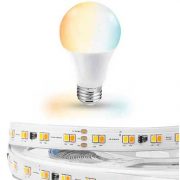
According to the US Office of Energy Efficiency and Renewable Energy, white tunable lighting is “the ability to control a light source’s color temperature output.” Manufacturers have achieved this innovation by combining LEDs of different color temperatures into single bulbs or strips. By controlling the LEDs inside the bulb or on the strip, you can then shift (or “tune”) the color temperature within a fixture. This may sound like a simple feature on its surface, but it is in reality a game-changer for many industries and environments – and, as we will see, perhaps even for all people everywhere.
Tunable white LED lighting is a groundbreaking type of lighting that technically combines multiple lighting sources. Without these multiple sources, the shifting or tuning that we are describing would be impossible. It is only through specific changes, turning off one LED and turning on another, that we can achieve the incredible effects for which this type of lighting has become known. A marvel of both engineering and human psychology, tunable white LED lighting promises to change the world in a significant way – to a degree that no other type of lighting has since the first incandescent lightbulbs appeared on the market in the 19th century.
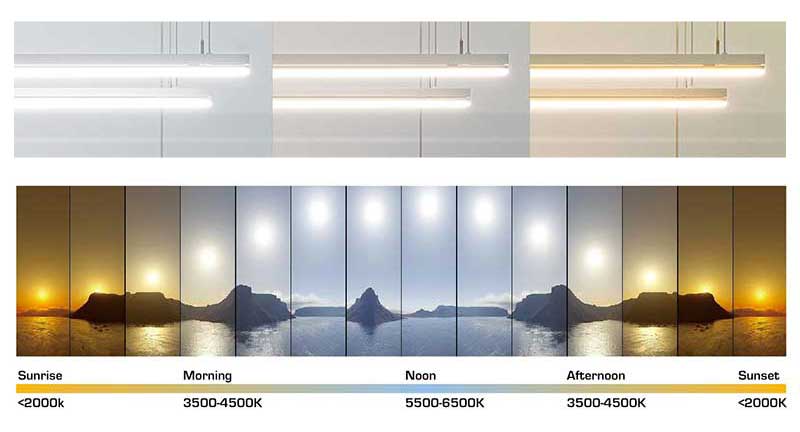
Unlike any other type of lighting, tunable white LED lighting connects directly to our minds, not physically but conceptually. Because we can shift the color temperature in a tunable white LED lighting fixture, we can optimize it according to the environment or even according to the time of day. That way, we can align the light with our circadian rhythm to better match the gradual dimming effect that humans experienced for eons living in the wild, underneath the sun during the day and underneath the moon at night. Gone are the days of glaring, overwhelming lightbulbs, their insistence on shining the same bright beams down on people regardless of appropriateness, impossible to control.
We can think of tunable white LED lighting as “custom temperature lighting.” This is not custom in the sense that we need to personalize it in the factory, though. This is custom in the sense that we can personalize it on the fly, making changes as we need to make them, lowering or raising the color temperature according to our moods, whims, and desires. We need no better reason than “I want the light to be different” to reach for our tunable white LED lighting controller and then press a button or turn a knob, however our system happens to receive our input. This is lighting that is ushering in a new and unprecedented level of convenience and control.
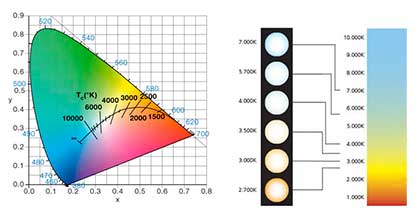
To measure the white light produced via tunable white LED lighting, we use color correlated temperature (CCT). CCT figures correspond to our real-world experiences of lighting, and we measure them in degrees Kelvin. To give you an idea of what CCT means, consider the measurements 1,800 Kelvin and 7,000 Kelvin: the former corresponds to candlelight and the latter corresponds to daylight. When you see a tunable white LED lighting system that features a range within two CCTs, it means that the lighting can run between those two CCTs – and perhaps along them as well, hitting infinite possible CCTs. One key point to remember is that the higher the CCT in Kelvin, the “cooler” white it will yield, emitting a bluish white (the “coolest” white) at the highest CCT in Kelvin.
As researchers at Rensselaer Polytechnic Institute put it, CCT is “simpler to communicate than chromaticity or SPD, leading the lighting industry to accept CCT as a shorthand means of reporting the color appearance of ‘white’ light emitted from electric light sources.” This is just a straightforward way for us to talk about what we are perceiving when we look at a source of white light.
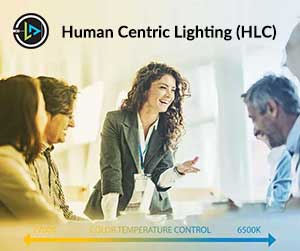
Mark Halper at LEDs Magazine refers to tunable white LED lighting as “human-centric lighting,” and in recent years, this term has caught on throughout the industry. We will examine in greater detail the reasons this term fits what we can also call tunable white LED lighting. You already know, however, that tunable white LED lighting can match the human circadian rhythm, and this is an elucidating point. You can learn more about circadian rhythm in this article, which discusses how inextricable it is for overall health and wellness. Once we understand how tunable white LED lighting meshes with what we naturally expect and desire from our lighting sources, the rest of its benefits starts to make much more sense.
In addition to tunable white LED lighting and human-centric lighting, this type of lighting goes by a variety of names. Another is “dim to warm lighting.” This term states in the least-assuming way possible what the lighting type is accomplishing, moving from a dim color temperature upward to a higher one, its color temperature not fixed, a major step away from every other type of lighting that the market had seen previously.
Yet another term for tunable white LED lighting is “full-color tuning,” which refers to the capacity of the lighting type to emit light that captures the breadth of color temperature. Even more complimentary than “dim to warm lighting,” this term expresses the choice that has made it so captivating for people who are tired of purchasing lighting fixtures only to become dissatisfied with their color temperatures a short while later (and find themselves stuck with it, totally lacking control).
Whatever we call tunable white LED lighting, the most critical idea for us to realize is how drastically it differs from all other lighting types. Everything it accomplishes, it is the first lighting type to do so. Next, we are going to review how tunable white LED lighting accomplishes what it does – through the blending process.
The Blending Process
There is no way to understand tunable white LED lighting without first understanding how blending works. The process, in this case, is inseparable from the technology. To fulfill its purpose, tunable white LED lighting must combine the outputs of multiple LEDs. By following algorithms to shift from one CCT to another, the highest-quality tunable white LED lighting systems will mix multiple white light outputs – merging channels that are all producing white light at different color temperatures, from the very warm all the way to the very cool.
In their overview of tunable white LED lighting, the US Office of Energy Efficiency and Renewable Energy called controls “a critical element in white-tuning systems.” This, however, is an understatement. Tunable white LED lighting is inseparable from its controls: without its controls, the “tunable” part of the name would cease to apply.
Using the right controls – which may function via wireless Zigbee, Wifi, Bluetooth, or other signals – we direct the blending process to achieve the CCT that we intend. While more primitive systems struggled to maintain consistency in color temperature, modern tunable white LED lighting has adopted real-time feedback systems that combat the color shifting that takes away from the overall output quality.
To comprehend what differentiates one tunable white lighting system from another, we can look at the concept of linear tuning, which is the most common. This type of tuning is a detriment to CCT, its linearity pushing CCT away from the curve of the blackbody, which is something that absorbs all the light around it. Doing so, it leads to inaccurate CCT that is not along the curve of the blackbody – marring the light with a pink hue error. It was only recently that technology for non-linear tuning became feasible, its multi-color LEDs remaining outside most budgets.
At LEDynamics, we believe the most elegant non-linear white tuning solution involves an algorithm that combines pointed and precise amounts of green light, causing CCT to shift along the curve of the blackbody in a nonlinear movement, eliminating the hue error inherent to linear tuning. More on this later.
Where Tunable White LED Lighting Fits
![]()
Tunable white LED lighting is, of course, much more than a trend or a novelty. This is lighting that can make life better for people. We have discussed how tunable white LED lighting can adhere to the human circadian rhythm to a degree that no other lighting can. This may sound intriguing in theory, but what does it mean in the real world? When we say that tunable white LED lighting is “human-centric lighting,” what are we talking about? It is undeniably interesting that we can change the color temperature of a light. We may even find ourselves thinking Wow, how far science and engineering have come. Now, let’s look more closely at what these advances mean for the world.
To understand why tunable white LED lighting has shown such immense promise, we only need to consider its potential effects. This lighting can adapt to people’s moods, responding to the shifts that people need to experience to feel comfortable in any environment, raising or lowering the color temperature in such a way that people’s mental health will benefit. It can also adapt to interior styles, expressing ideas and emotions in an environment, immersing people in these ideas and emotions and heightening the impact that the space has on people.
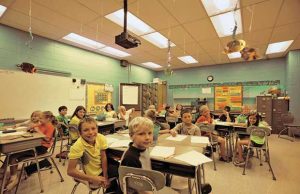
 One study out of the Pacific Northwest National Laboratory reported that within an elementary-school classroom in Fulsom, California, students performed better when they were doing their schoolwork under tunable white LED lighting. The Department of Energy had funded the study to analyze the cost savings they could expect by installing such lighting on a large scale. As striking as their findings about the savings were – amounting to costs that were somewhere between 48% and 69% lower – their findings about academic success were even more inspiring, conjuring up images of students nationwide studying and thriving under tunable white LED lighting in the school years ahead.
One study out of the Pacific Northwest National Laboratory reported that within an elementary-school classroom in Fulsom, California, students performed better when they were doing their schoolwork under tunable white LED lighting. The Department of Energy had funded the study to analyze the cost savings they could expect by installing such lighting on a large scale. As striking as their findings about the savings were – amounting to costs that were somewhere between 48% and 69% lower – their findings about academic success were even more inspiring, conjuring up images of students nationwide studying and thriving under tunable white LED lighting in the school years ahead.
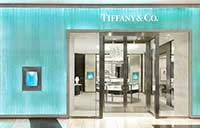
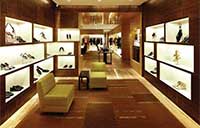
Another study exhibited the usefulness of tunable white LED lighting in retail, where the lighting boosted sales. Time and again, researchers have concluded that tunable white LED lighting is simply preferable. This is lighting that people appreciate and that they feel comfortable around. Because diamonds appear most attractive under cooler color temperatures but other metals and colored stones appear more attractive under warmer color temperatures, jewelers can optimize their sales processes through tunable white lighting – or even apply white light to white surfaces for even more stunningly minimalist appearance.
Because tunable white LED lighting can improve people’s moods, it fits anywhere that people’s moods come into play. Retail environments, schools, and healthcare settings are the most obvious places where tunable white LED lighting would serve clear and immediate purposes, but in offices too, tunable white LED lighting is making a difference – not only helping people to feel happier and more comfortable but also enhancing productivity levels across teams, motivating people to work harder and to think more creatively.
This incredible lighting type also seems capable of shifting people’s perceptions of actual temperature. Conceivably, businesses in Minnesota could install tunable white LED lighting and change the color temperature in January to instill a perception of warmth. Businesses in Florida, meanwhile, could install tunable white LED lighting and change the color temperature to instill a perception of relief from the overbearing hot outside.
The entire atmosphere within any environment is malleable, all thanks to tunable white LED lighting. You can decide what you want people in an environment – or just yourself – to feel or think, implementing tunable white LED lighting as a tool to push perceptions in the right direction. Tunable white lighting can prevent post lighting installation issues that may arise, when customers decide that the project feels too cool or too warm. Thanks to tunable white lighting, the color temperature is no longer permanent once the fixtures are installed. Planning and execution often falling into disconnect between one another, this level of control allows people to change their minds – say switching from a black granite table (which would look best under a cool color temperature) to a dark wood table (which would look best under a warm color temperature).
In the near future, it seems likely that tunable white LED lighting will become the lighting type of choice, for those who recognize its value at least. It only makes sense that hospitals, offices, schools, and other sensitive environments will install tunable white LED lighting en masse once the word is out. For many professionals and experts in the lighting field, this remains something of an open secret, the inventiveness and the undeniable value of tunable white LED lighting constantly on display for all to see but still remaining just out of conscious view for people who have not heard of it or who have not gone looking for it on their own.
Think of it as a club, and now you are a part of it.

A Clear Choice

Never before has a lighting innovation coalesced so well with what people need out of their lights. Long before we knew it, traditional lighting was disrupting our circadian rhythm, and for many urban dwellers, a good night’s sleep remains ever-elusive because of the bright incandescent lights that pour through their windows at all hours. Think about the popular image of the insomniac unable to escape the ever-present glow of the brightly-lit billboard outside her window. This is an extreme example, of course, but it illustrates the effect that lighting can have on our lives. We crave lighting that aligns with our moods and desires.
Other types of lighting feature two modes – on and off. Through the most advanced tunable white LED lighting systems, there are infinite modes, all of the degrees of color temperature within the color temperature range of which each system is capable. Whatever you want out of your space, however you want your lighting to make you feel, it is possible. Wake up to the softest trickle of light, like the gently rising sun. Do your work beneath something a little bit cooler and a little brighter.
Tunable white LED lighting is poised to fundamentally alter our relationship with lighting. We are looking beyond the “on/off” switch and thinking about everything we have ever wanted lighting to be. If you have dreamed about a lighting system that accounted for your vision within your home, office, restaurant, classroom, hotel, or retail location, tunable white LED lighting is for you. The future of lighting is unfolding before your eyes – gradually, of course, and ever so gently – and you are welcome to take it in and then take control of it at your leisure.
This is the lighting type that we have all been waiting for. For everyone who has ever thought that something better must be possible, we want to tell you – it is. We want to state in no uncertain terms that tunable white LED lighting is different.
This is the cutting edge of lighting, and our team at LEDdynamics is working on the cutting edge of that – the cutting edge of the cutting edge. We are the first lighting manufacturer to create a non-linear tunable white lighting solution that uses green correction, and we want to show you what a difference it can make. This is a thrilling innovation. We have invested in it heavily, and we remain focused on it, confident that this is the next great frontier in lighting. Changing spaces worldwide, we are proud to stand up as pioneers in human-centric lighting.
LEDdynamics, Inc. powers LEDs. In 2001 LED drivers like the MicroPuck, PowerPuck and BuckPuck emerged into the LED industry helping to increase the efficiency of LEDs. LED manufacturers, at the time, were so focused on increasing light output that efficiency was all but ignored. Before LEDdynamics, the approach to powering LEDs was as if you glue the gas pedal to the floor of a car and use the brake to regulate the speed; products were commonly wasting half of the battery’s energy. LEDdynamics’ LUXdrive line of LED drivers added value by maximizing LED energy potential by utilizing more of the battery power.

A LED driver is an electrical device that regulates the power to an LED or string(s) of LEDs. What makes a driver different from conventional power supplies, is that an LED driver responds to the ever-changing needs of the LED, or circuit of LEDs, by supplying a constant amount of power to the LED, as its electrical properties change with temperature.
Think of an LED driver as ‘Cruise Control’ (like in a car) for the LED, and the temperature changes of the LED are the hills and valleys it is ‘driving’ over. The power level (or ‘Speed’) of the LED is maintained constant by the driver as the electrical properties change (amount of ‘gas’ or power needed) throughout the temperature increases and decreases (or ‘hills and valleys’) seen by the LED(s). Without the proper driver, the LED may become too hot (driving too fast) and become unstable (out of control), causing poor performance (engine problems) or complete Thermal Runaway (crash!).
In most cases, YES! The semiconductor junctions in an LED (which produce the light) require very specific electrical power to operate properly. If the voltage (electrical force) supplied to the LED is lower than required, very little current (electricity) flows through the junction, resulting in low light output and poor performance. If the voltage is too great, too much current flows and the LED can overheat and be severely damaged or fail completely (thermal runaway). Configuring an appropriate LED driver for each application is essential for maintaining the optimum performance and reliability of the LED(s).
Also, different types and models of LEDs have different voltage requirements even though they may share the same current rating. Beyond that, the voltage required to achieve the proper current can vary with temperature, composition of chemicals in the LED, etc. Therefore, LEDs with the same part number may have variations in the precise level of voltage required for proper operation. Generally, it is desirable to regulate the current flowing through each LED to the rated current to maximize the illumination and life of each costly little LED. To do this, some type of true power regulation is required. A resistor can be used as a cheap solution to restrict the current flow, but since a resistor turns power into heat to do its job, the resistor often wastes more power than the LED saves while adding to the heat that needs to be removed.
There are a few applications in portable lighting where a driver is not completely necessary and a simple resistor is used (however, this is not recommended!). This is the case for many multi-cell flashlights using LEDs since it is a very cheap solution. By placing the correct resistor in line with the LED, the available rate of power from the batteries is restricted to a level low enough to be tolerated by the LED. Since the available power from the battery will decrease as it is consumed by the LED, the light level will begin to drop as soon as the unit is turned on and power is taken from the batteries. The major disadvantages to using a resistor on an LED are linear light drop-off (light level begins decreasing as soon as power is switched on), poor efficiency (the resistor is consuming much of the power), and no thermal protection (the LED may overheat and there is nothing there to stop it!). A dynamic resistor, like the DynaOhm™ from LuxDrive, can be substituted for the resistor to improve light output and provide thermal protection.
Choosing the right LED driver is like choosing the right tool for the job. First, you need to know what that job is! Here are the main questions you should have the answers to before choosing a driver:
Once these questions have been answered, choosing the correct driver is a matter is finding what is currently available and determining if it is suitable for your application. Use the following table or this LED Driver Selector Tool to help in determining if a driver is available for your application. Select the part number to find out more about the selected driver.
| Product | Type | Topology | Input | Output | Dimming | |
|---|---|---|---|---|---|---|
| QuadPuck 4016 | DC:DC | Buck | 12 to 24 VDC | 1000 to 2100 mA | PWM | Data Sheet |
| QuadBlock F017 | DC:DC | Buck | 12 to 24 VDC | 1000 to 2100 mA | PWM | Data Sheet |
| PowerPuck 2008B | DC:DC | Buck | 5 to 32 VDC | 350 to 1000 mA | None | Data Sheet |
| MiniPuck F004 | DC:DC | Buck | 6.5 to 30 VDC | 350 to 700 mA | PWM | Data Sheet |
| MicroPuck 2009 | DC:DC | Buck | 0.8 to 3 VDC | 350 to 600 mA | None | Data Sheet |
| FlexBlock A011 | DC:DC | Buck-Boost, Boost | 10 to 32 VDC | 350 to 700 mA | 0 - 10 V | Data Sheet |
| DynaOhm 4006 | DC:DC | Linear | (2.6V + Vf) to 52 VDC | 20 to 30 mA | None | Data Sheet |
| BuckToot 7027 | DC:DC | Buck | 5 to 28 VDC | 350 mA | None | Data Sheet |
| BuckPuck 302xD | DC:DC | Buck | 5 to 32 VDC | 350 to 1000 mA | 0 - 10 V | Data Sheet |
| BuckBlock A009 | DC:DC | Buck | 10 to 32 VDC | 1000 to 2100 mA | 0 - 10 V | Data Sheet |
| BuckTitan N009 | DC:DC | Buck | 6 to 30 VDC | 1500 to 3000 mA | 5V PWM | Data Sheet |
| MultiBlock N022 | DC:DC | Boost | 12 to 24 VDC | 120 to 1200 mA | None | Data Sheet |
| BoostPuck 4015 | DC:DC | Boost | 5 to 28 VDC | 350 mA | 0 - 10 V | Data Sheet |
If you cannot locate a driver suitable for your application, you may consider contacting a driver engineering company (like LEDdynamics, Inc.) to have a driver designed for your specific application. Many of the LuxDrive line of LED drivers can be redesigned for fit your application at little or no additional cost. Contact LuxDrive Support for more information.
NOTE: Always refer to the manufacturer’s instructions before making any connections!
In most cases, an LED driver has (4) connections: (2) for the power input and (2) for the LED. Drivers with dimming capabilities will often have (2) additional connections for a dimming pot or control connection. If you are connecting a circuit or string of LEDs, be sure the circuit is configured for the driver to be used. Incorrectly wiring the LED(s) may damage the LED(s) and/or the driver. Also, many driver manufacturers require connection of the LED(s) before power is applied.


Light Emitting Diode
LEDs, or Light Emitting Diodes (a diode is a device that only allows electricity to flow through it in one direction, which is why LEDs have a positive (+) side and a negative (-) side) are silicon wafers that emit photons (light) when an electrical current passes through it.

LED Light Module

Discrete LED
Discrete LEDs provide only a light source and leave the details of configuration, mounting, polarity, and alignment to the end user.
A LED light module is a single or multiple discrete LED(s) configured and mounted to a printed circuit board with polarity connections. LEDdynamics designs and manufacturers LED light modules to help companies get access and easily use the latest LED technology.

LED Light Engine
A LED light engine is the same as a LED light module with the addition of LED driver electronics. This allows the LED to connect directly to power.
The most significant distinction between traditional lighting devices (an incandescent light bulb, fluorescent tube, neon fixture, etc.) and LEDs is that LEDs do not use heat or a gas to generate light. An LED is a ‘Solid State’ device that contains no fragile filament or glass tube, making it an extremely durable and reliable light source that can be used in ways never before possible.
The most common uses of LEDs are in consumer electronics and other equipment as indicator lights (the green or red ‘power on’ lights on a VCR or computer monitor).
Only with the introduction of HB (High-Brightness) LEDs and HF (High-Flux) LEDs, have LEDs been considered a “useable light source” for flashlights, accent lighting, signage, general-illumination and other applications.
LEDs are used in applications where long life and reliability is required. Many have been illuminated for 25 years and continue to function. Because LED use much less current than other light sources and run on low voltage DC, they are naturally suited for many battery powered applications. In very cold temperatures, LEDs turn on instantly while some fluorescents would fail to light. LEDs also generate smaller amounts of heat than their incandescent (filament) counter parts.
To choose the right LED for your product or application, you should have a general understanding and knowledge of the different types of LEDs, their typical applications, and their differences in electrical, physical, optical and thermal characteristics. There are many different types and brands of LEDs on the market today and finding the LED that best suits your particular project requirements is essential for achieving the maximum performance, longevity and overall success of your LED product or application.
The first consideration when choosing an LED is to determine if a particular wavelength or color is desired for the application. Determining a specific color range (wavelength) or temperature range (degrees kelvin) of light to be used will significantly narrow the range of available LEDs that are suitable, and that can be considered for the application.
Next, the type of available power and drivability of the LED needs to be determined. LEDs of different wavelength (color) and type have different power requirements, electrical characteristics and thermal management requirements. The type of available power is a major factor in determining the best LED or LED circuit configuration for the application. In higher voltage applications, it may be more suitable to use many smaller LEDs, in place of one or two larger LEDs, to reduce the amount of power and heat that needs to be regulated.
Refer to the LED manufacturers’ specification documentation for information on electrical, physical, optical and thermal characteristics in order to become familiar with the LEDs that are being considered for the application, or contact LEDdynamics support for more information on how to choose the right LED and driver for the job.